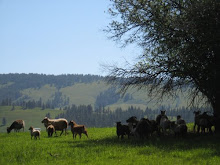I was following up on one of my posts on a forum I belong to and realized that I had not yet posted this information on this blog.
The example I posted earlier about the broccoli and the fact that Idaho grows so many potatoes should bring to light one of the problems I see in agriculture today.
In the old days, farmers (including very large farms) grew a multitude of crops. People knew that they could get whatever they wanted within a short distance. But these huge Ag companies have narrowed down the varieties of what they grow. Now we have huge areas that only grow one vegetable. In fact, only one variety of vegetable. Now, what happens when a disease comes through an area? You get crops completely wiped out.
It is what happened when the blight wiped out the potatoes and caused the great Irish famine.
The same thing happened with the bananas. We began growing almost exclusively one variety of banana, the Gros Michel, a banana that was larger and, by all accounts, tastier than the fruit we now eat. A fungus called Panama disease began infecting it and by the 60's it was virtually wiped out. Now what we think of as the banana is actually a second rate replacement called the Cavendish. If it happens again, the third variety down the line is a pretty poor substitute. And, in 1992, a new strain of the fungus, one that can affect the Cavendish, was discovered in Asia and most experts agree that we have major problems coming. We may not have bananas as we know them in ten years.
Because of these giant Ag companies taking over our food supply we are losing varieties of fruit, vegetables and farm animals at alarming rates.
Here are some examples:
96-98% of the commercial vegetable varieties available in 1903 are now extinct.
Reliance upon modern varieties of rice caused more than 1,500 local rice varieties in Indonesia to become extinct.
In the USA, only 5% of the apple varieties that existed 200 years ago still remain.
In the UK, 90% of vegetable varieties have disappeared over the last century.
99% of all turkeys raised in the U.S. are Broad-Breasted Whites, a single turkey breed specially developed to have a meaty breast.
83 percent of dairy cows are Holsteins, and five main breeds comprise almost all of the dairy herds in the US.
60 percent of beef cattle are of the Angus, Hereford or Simmental breeds.
75 percent of pigs in the US come from only 3 main breeds.
Over 60 percent of sheep come from only four breeds, and 40 percent are Suffolk-breed sheep.
The less varieties we have of all of our food the more of a chance that we can have them wiped out by disease or by climates that they are not meant to be grown in. The varieties being lost were developed in micro climates and were able to thrive. When we try to grow the same variety everywhere we are looking for trouble.
So, buy heirloom varieties when growing your garden. If possible pick wacky varieties that are at risk of extinction. Keep them alive. We are all part of the solution.
On our place, every variety of vegetable in my garden is an heirloom and our sheep, horses and chickens are all rare breeds.
Do what you can and can what you do.

No comments:
Post a Comment